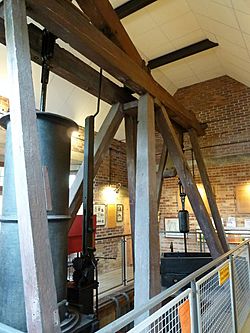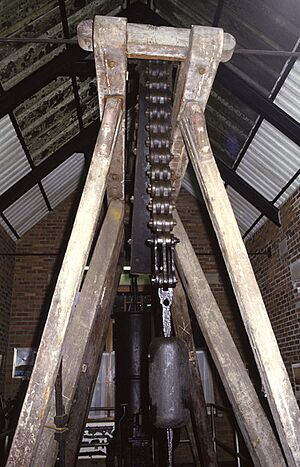Newcomen Memorial Engine facts for kids
Quick facts for kids Newcomen Memorial Engine |
|
|---|---|
 |
|
| Origins | |
| Type | Newcomen atmospheric engine |
| Designer | Thomas Newcomen |
| Date | 1725 |
| Country of origin | England |
| Former operator | Various |
| Purpose | Pumping water: Mine drainage, later canal supply |
| Measurements | |
| Cylinders | 1 |
| Bore | 22 inches (56 cm) |
| Stroke | 5 feet (1.5 m) |
| Preservation | |
| Location | Dartmouth Visitor Centre, Devon |
| Coordinates | 50°21′08″N 3°34′42″W / 50.35228°N 3.57845°W |
| Working | No |
The Newcomen Memorial Engine is a very old and important machine found in Dartmouth, Devon. It's also sometimes called the Coventry Canal Engine. This special engine was saved to remember Thomas Newcomen, who invented the first practical steam engine. He was born in Dartmouth and passed away in 1729.
This engine is amazing because it's the oldest steam engine in the world that still exists today! It shows us how people used to solve big problems, like draining water from deep mines, a long time ago.
Contents
What is a Newcomen Engine?
Newcomen engines were powerful machines designed to pump water. They were often called 'fire engines' because they used steam, created by fire, to make them work. The very first successful Newcomen engine was built in 1712 near Dudley Castle.
These engines were super important for mining, especially for coal mines. They helped remove water that would flood the mines, making it safe for miners to dig deeper. By 1733, over 100 of these engines were in use, and eventually, more than two thousand were built!
The Engine's Long Journey
The Newcomen Memorial Engine has a fascinating history, moving between different jobs and locations. It shows how valuable these machines were, even as newer, more efficient engines were invented.
From Mine to Mine
The exact beginning of this engine is a bit of a mystery, but it was likely built around 1725. It first worked at Griff Colliery, a coal mine near Nuneaton. Here, it pumped out huge amounts of water, about 68,200 litres every hour!
This engine was not very big for its time. It had a simple wooden beam, about 3.6 meters long, that helped it pump water. It was also built on a wooden frame, not inside a special engine house.
After the Griff Colliery closed, the engine was sold in 1731. It then moved to Oakthorpe Colliery near Measham, where it continued its important work of draining water from the mine. It stayed there for almost a century!
Getting Upgrades
Over its long life, the engine received several upgrades. When James Watt invented a much better way to make steam engines more efficient, older Newcomen engines were often improved.
One clever upgrade was called the 'pickle pot' condenser. This device helped the engine use less fuel, similar to Watt's invention, but it was designed in a way that didn't break Watt's patent rules at the time. This upgrade meant the engine's boiler had to be moved from its original spot.
Other improvements included stronger metal chains instead of older link chains. The engine's valves were also updated to make it run more smoothly.
Pumping for Canals
Around 1821, the engine was sold again, this time to the Coventry Canal Company. It was no longer needed in the mines, but it found a new purpose! It was moved to Hawkesbury Junction in Warwickshire.
Here, it pumped water from a well to keep the canal levels steady. A special engine house was built for it in 1837, which you can still see today. The engine worked for the canal until 1913, serving for over ninety more years! This is why it's sometimes called the "Coventry Canal Engine."
Preserving History
In 1963, the Newcomen Society decided to save this incredible engine. They wanted to celebrate the 300th anniversary of Thomas Newcomen's birth. The engine was carefully moved to Dartmouth, Newcomen's hometown.
It was set up in a new museum called the Newcomen Engine House. This building also houses the local Tourist Information Centre. Today, the engine is powered by modern hydraulics so visitors can see it moving, just like it did hundreds of years ago! It's a fantastic way to see a piece of history in action.


